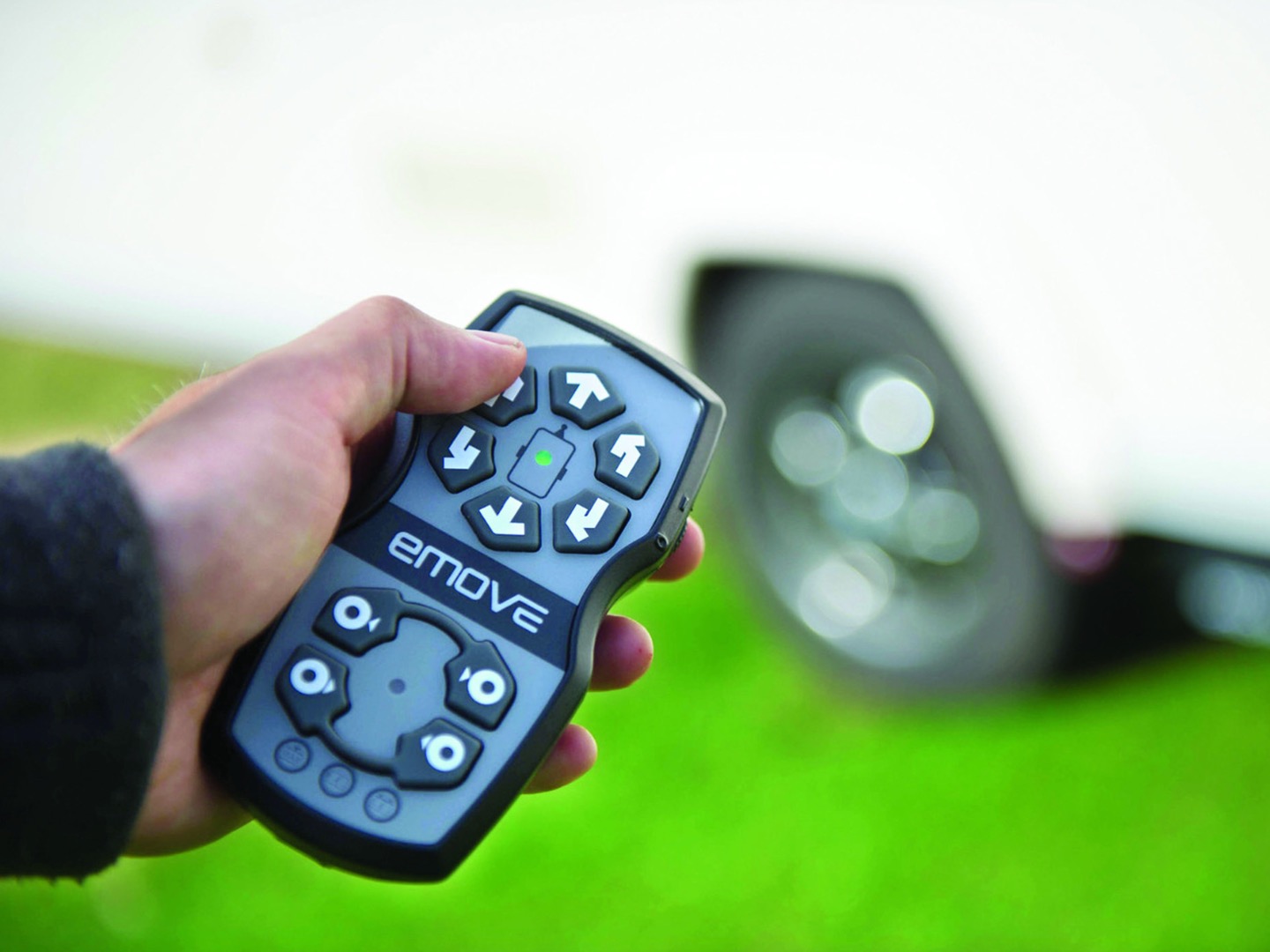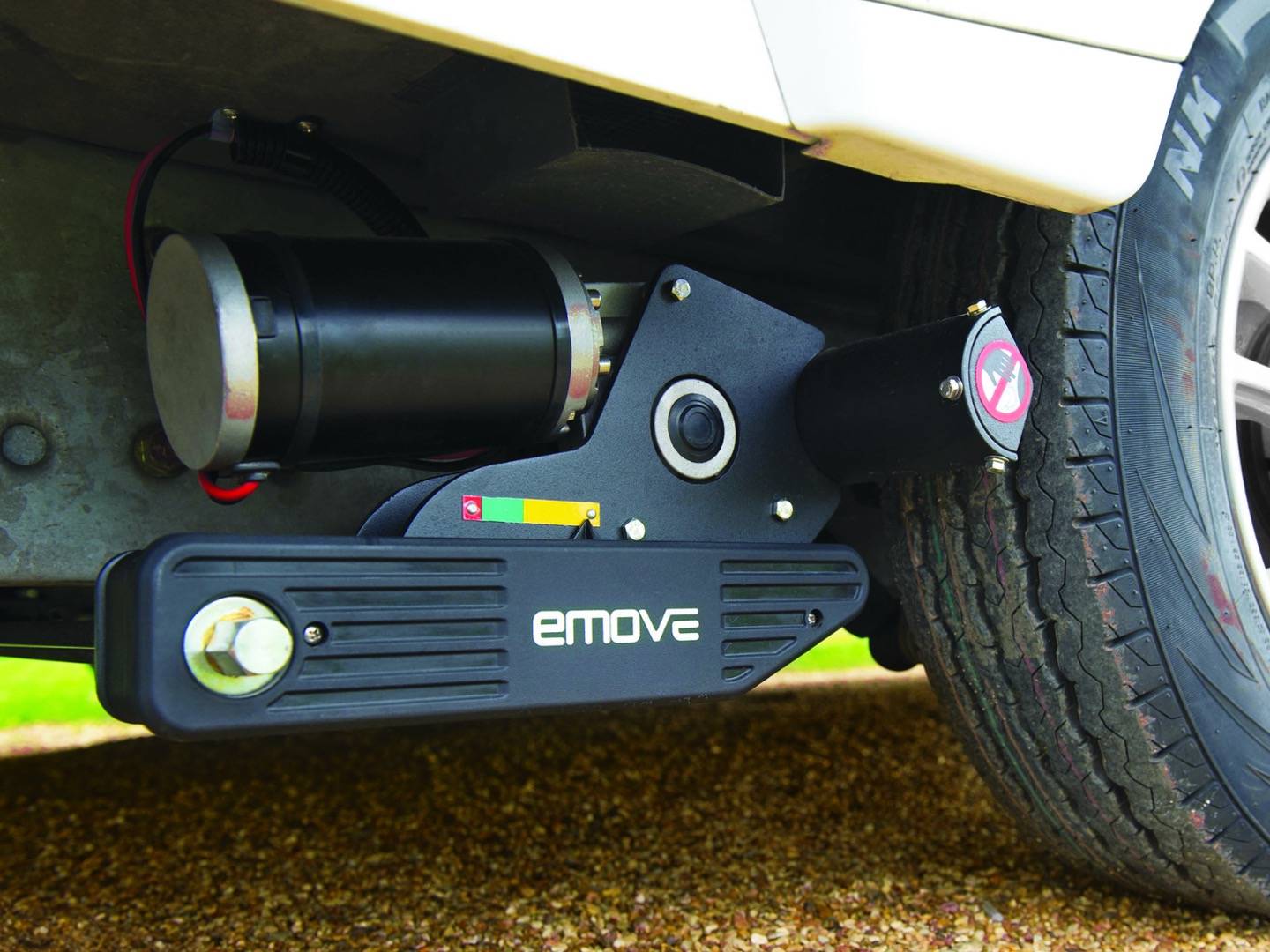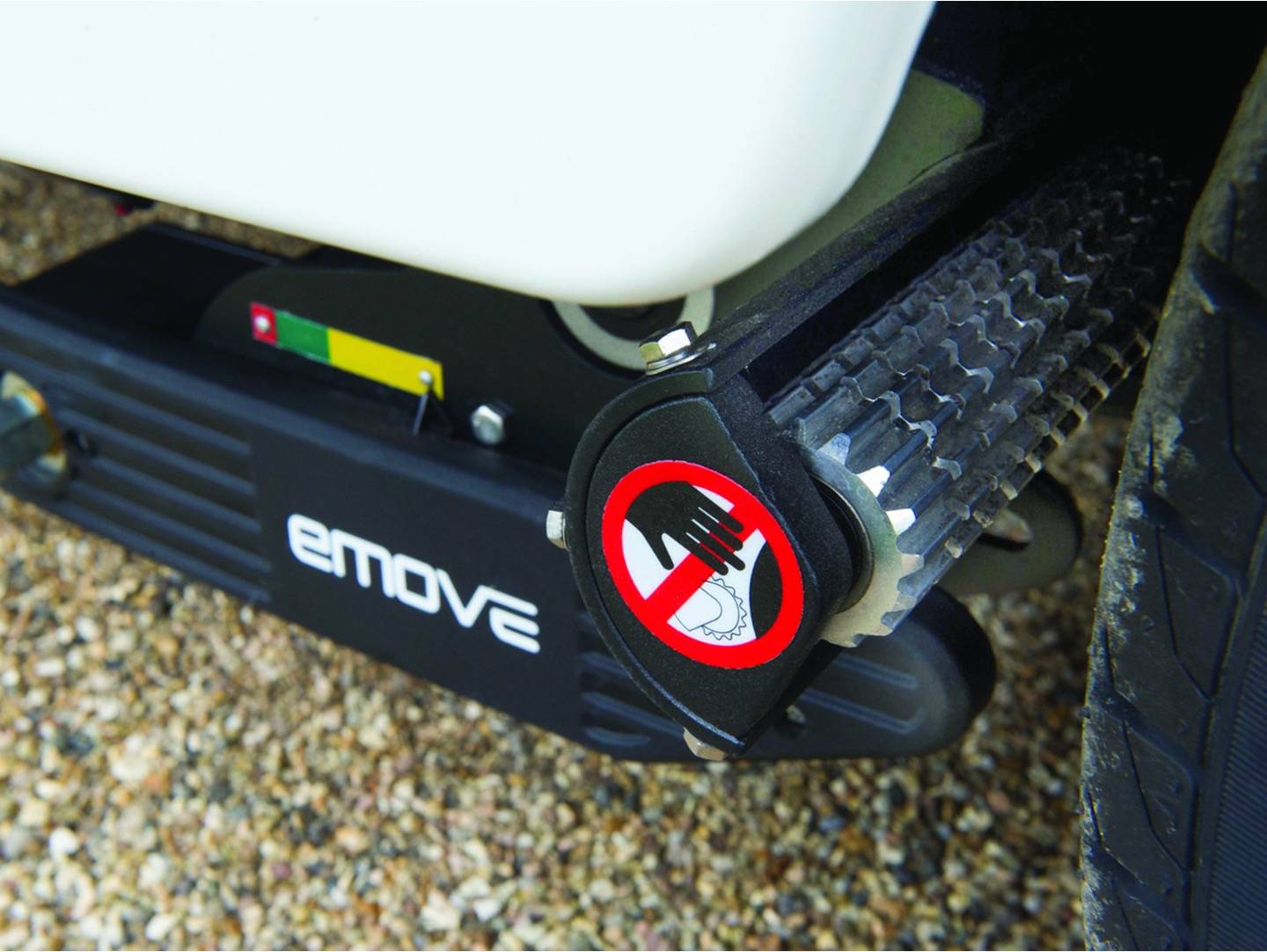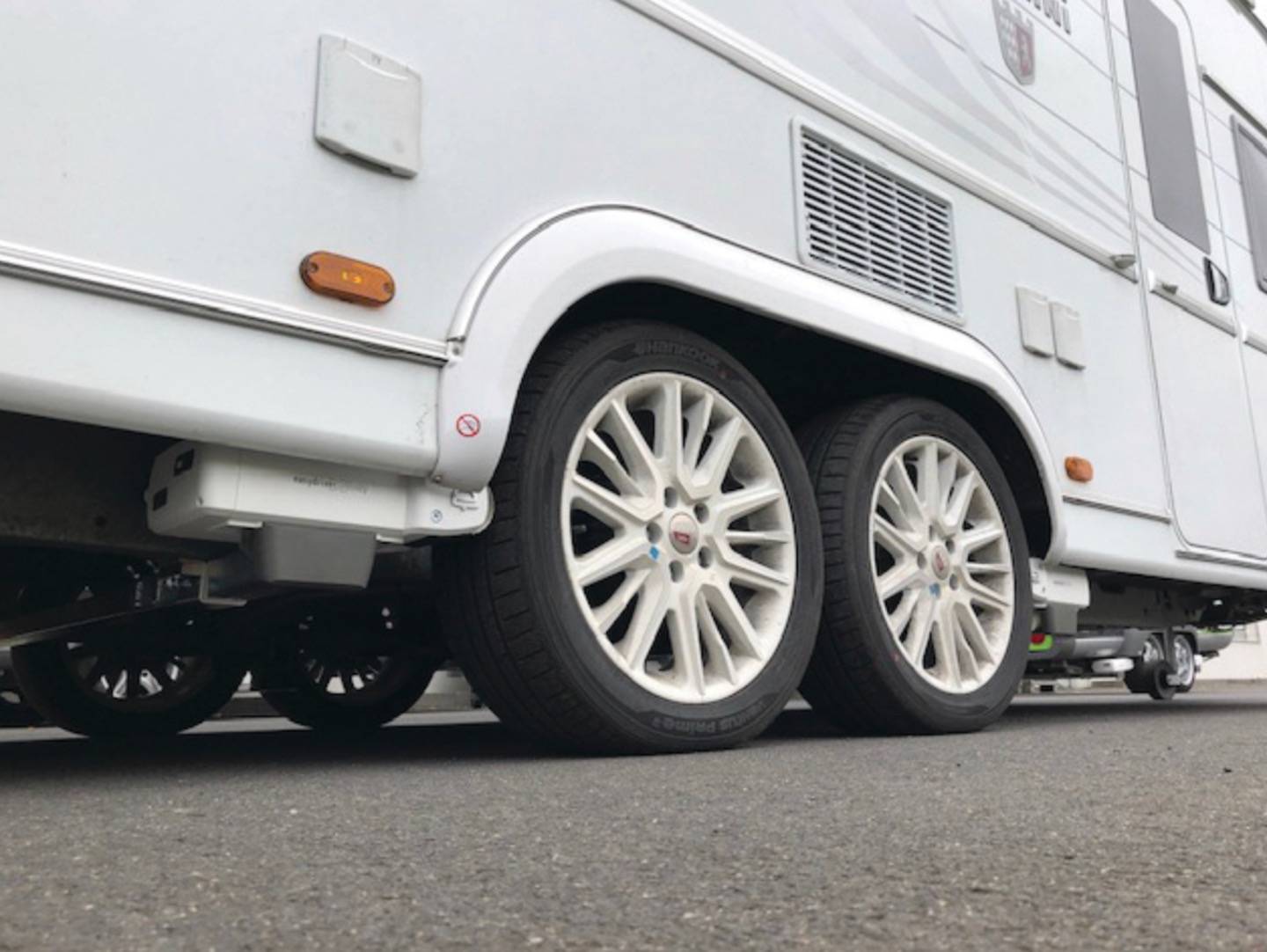The ultimate guide to caravan motor movers
Discover the convenience of a motor mover—an innovative electronic device designed to transform your caravan manoeuvring.
Easily fitted to your caravan, this device, equipped with two or four motor units based on your caravan type, empowers you to navigate your caravan remotely.
Page contents
- What is a motor mover?
- Fitting a caravan motor mover
- What to consider when using a motor mover
- FAQ
- About Caravan magazine
Words by Louise Cottrill
What is a motor mover?
The system includes an electronic control unit and a user-friendly handheld remote, offering seamless control over your caravan’s movements.
Say goodbye to manual struggles and welcome a new era of effortless caravanning with the motor mover, enhancing both convenience and control.
Why do I need a motor mover for my caravan?
Caravan motor movers not only add a touch of coolness to any campsite but also serve as stress-relievers during tricky manoeuvres, or when positioning your tourer in tight storage spaces at home. These nifty devices combine practicality with a dash of style, making the caravanning experience smoother and more enjoyable.
A caravan fitted with a motor mover can almost turn on its own axis, so they’re perfect for moving a caravan into a tight spot; say, between a garage wall and a fence post. This has the added bonus of making the caravan far more difficult to remove, thereby increasing security.
Every caravanner’s worst nightmare is having to manoeuvre onto a difficult campsite pitch with half the site watching you from their deckchairs! A mover eliminates these worries and may also save wear and tear on your towcar’s clutch, especially if the pitch access is sloping.
Once you’re close to your pitch, unhitch the caravan and lower the jockey wheel, turn on the mover’s master switch, engage the rollers, then release the handbrake and use the handheld remote to ‘drive’ the caravan perfectly onto the pitch – wherever you are! Remember that the further you manoeuvre your caravan, the more power you will sap from your leisure battery.
Movers are also handy for precisely manoeuvring onto levelling ramps on sloping caravan pitches, and for aligning the receptors for Al-Ko wheel locks.
How does a motor mover work?

(Photo courtesy of Streetwize)
The handheld remote communicates with the mover’s computer system through radio waves, enabling the caravan to be remotely navigated using the handset. Directional buttons are typically pressed to guide the caravan.
The independent activation of the caravan’s wheels allows for tight turns, with one side rolling forward while the opposite side stays still.
It’s essential to power motor movers with 12V electricity from the caravan’s leisure battery, avoiding use with mains or campsite hook-up to prevent damage to the system.
Fitting a caravan motor mover

(Photo courtesy of Streetwize)
Traditional motor movers are bolted to the caravan’s chassis next to the wheel(s). Typically, they hang below the chassis, but there are two drawbacks to this:
- They get very dirty as corrosive water, dirt and salt are sprayed off the tyre straight onto them
- As they hang below the chassis member, they lower the ground clearance of the caravan and are in a prime position to be struck by a speed bump, raised ironwork or if a wheel drops into a deep pothole.
Al-Ko’s Mammut motor mover counters these issues by being fitted on the side of the chassis member, therefore giving four to six inches (10-15cm) of extra ground clearance.
What to consider when using a motor mover

(Photo courtesy of Streetwize)
Ground clearance
As mentioned, the distance from the Tarmac to the base of the mover is crucial to minimise the chances of damage. Four inches (10cm) should be an absolute minimum, but six to eight inches (15-20cm) is better.
Battery choice
Most motor mover manufacturers recommend powering them with a minimum 100Ah leisure battery.
These batteries can cost in excess of £100, and can be significantly bigger than a typical 70 or 80Ah battery. Not only does this mean they weigh more, but they are physically larger, too, so check that they will fit into your battery compartment before you commit to purchasing one.
Be aware that it is illegal and dangerous to custom-fit a leisure battery within the living space of your tourer (say, in an under-seat space); they should always be in a separate compartment, sealed off from the living quarters, and with good ventilation.
Always budget for one of these more-expensive batteries when you do your calculations.
Cabling
Aim to keep cable runs to the motors a similar length. Do not coil excess cable tightly, as this can result in heat build-up.
Tyre damage
Don’t leave your mover’s grooved rollers pressing into the tyres for long periods, as you may cause permanent misshaping and an annoying flat spot.
Likewise, ensure that the rollers are withdrawn from the tyre before you begin towing. Some movers have fail-safe systems built in to prevent this potentially dangerous faux pas.
Buying secondhand
Purchasing secondhand motor movers is a viable option, though the standard caution for buyers applies, and warranties are unlikely. Reputable caravan dealerships often offer well-maintained motor movers from part-exchanged caravans as optional extras or incentives for new or used tourers.
As relatively simple equipment, a well-maintained motor mover is less prone to issues. Regular checks to ensure proper functioning are crucial. If you’ve invested £500 to £2,000 in a motor mover, taking it with you when changing caravans is practical, costing around £200 for professional assistance. DIY removal and refitting are feasible for those with basic technical skills and tools.
How much is a motor mover?
The cheapest movers are refurbished ones and cost from around £450. You’ll want to make sure yours comes with at least a one-year warranty
Budget new mover systems cost from around £600, for a recognised brand with warranty. Cheaper new makes may be available on the internet (from the Far East), but we can’t recommend them.
Expect to pay up to £1,200 for a top-notch single-axle system and around £2,000 for a top-quality twin-axle system. Always negotiate, and look at some of the great motor mover deals when buying a new caravan.
How do I get a motor mover fitted?
Your local dealership will be able to fit your motor mover in under half a day. Negotiate the fitting price before you buy the unit (remember battery requirements).
As always, we recommend NCC-approved, AWS-level technicians and workshops to carry out any major work on your caravan, as this will ensure you maintain any warranty cover.
Can I fit a motor mover to my caravan?

(Photo courtesy of Streetwize)
Yes, if you are a ‘practical type’ with decent technical knowledge. You will only require a range of basic tools to do the job.
Typically, that will include a ratchet set, spanners, screwdrivers, drill, rubber mallet, tape measure, pencil and hammer. Plus sealant, trunking and cable ties. This isn’t for everyone!
Other moving options
Fitted units are, by far, the most popular form of motor mover, but devices with small ‘caterpillar tracks’ that attach to your jockey wheel, such as the Camper Trolley mover, and entirely separate motorised units that attach to your caravan hitch, like the Multi- Mover, are available.
The latter, in particular, will not add to your tourer’s weight, and so is ideal if you just need help in manoeuvring your caravan into its safe space at home.
What about maintenance?
Caravan motor movers need relatively little maintenance, other than regular cleaning and lubrication, particularly of moving parts like the roller bearings and slide-out actuator mechanism. Visual checks of under-caravan wiring are recommended on an annual basis.
Also check the battery housing in your remote control for corrosion, particularly if it hasn’t been used for long periods through the winter.
How to extend your caravanning lifestyle
A motor mover is one of many devices and accessories that can help you extend your touring lifestyle as you get older and, perhaps, are less able to undertake manual exertions, such as pushing and pulling your caravan into position.
What are the options?
Motor movers come in various sizes, styles and price ranges.
Manual actuation v automatic actuation
The rollers on all motor movers slide out and press into the tyre tread for maximum contact and grip.
Many movers require the user to engage the rollers manually, by using a spanner or wrench to turn a hex bar (either on a screw thread or a cam action), which slides the roller forwards.
More expensive models have automatic, electronic actuation, where the user simply presses a button on the remote and the rollers slide out in an automated fashion. These are great, but cost more and weigh slightly more.
Manually actuated movers tend to have the motors on each side connected by a long length of bar. This is so that, if the caravan is stored very close to a wall, you only have to access one side to actuate both rollers, as, when you turn one side with your wrench, the other side turns, too. This is not an issue with automated actuation.
Single-axle or twin-axle models
Motor movers are available as single or twin-axle kits. A single-axle caravan only requires two motor units (one on each side), while a twin-axle tourer generally has four (one in front of the forward tyre and another behind the rear tyre). That said, we have seen twin- axle caravans with just one motor on each side.
Soft-start technology
The latest movers feature soft-start technology. This introduces the power slowly, resulting in much gentler acceleration and preventing anything from being shaken up or moved inside the caravan. After all, you don’t want the sediment in that lovely bottle of vino you’re carrying stirred up, do you?
FAQ
What sort of warranty will I get?
Most manufacturers confidently offer five-year warranties on their products. Some of these may be extended warranties with a fee attached. As these tend to be insurance-backed warranties, read the small print before signing.
Always ask what service is available, should you have a problem away from home and check what the warranty covers.
Do they last long?
A good-quality, well-maintained motor mover could easily last a decade or longer.
How do I look after the mover?
Maintenance is quite simple on most movers on the market – keep the mover clean and every six months grease the mover (follow appropriate instructions). Successful operation is dependent on a good battery. Keep the caravan leisure battery topped up.
The mover can operate at voltages below 12V, but it does have an automatic cut-out when the voltage drops to 11V. Keep the battery above 12V. When not in use for long periods, consider taking the caravan battery out of the caravan and top up occasionally with a bench charger.
Also, remember to take the battery out of the remote control.
Can I fit my motor mover or swap my existing one onto my new caravan?
Yes, you can do both. It’s relatively easy for anyone who’s handy with a spanner.
What are the latest mover developments?
Soft-start technology: Given that motor movers are located next to the wheel with all the associated grime and dirt, the very best materials must be used to ensure longevity.
For example, Powrtouch uses an aircraft-grade aluminium alloy, diamond-cut precision-machined castings, Alocrome treatment post-machining, durable powder coating, heat-treated high-strength steel gears, hi-torque four-pole motor and a super-grip aluminium roller. All combined with British design and manufacture.
Light and durable alloys and clever gearbox designs are making the latest movers much lighter than their predecessors.
Advanced mover technology is also making new units much lighter. The e-go range is 28% lighter than comparable units, giving you greater usable payload.
The latest movers, like some of those from Truma, feature three-phase brushless motors which give feedback to the control circuitry, so that it always knows what the motors are doing.
The result is an efficient and super-sensitive mover that can even trap an egg without breaking it and one that will manoeuvre straight, even if one or more wheels is going over obstacles.
Reich has some of the strongest movers on the market. You can control some via a smartphone app, just in case you can't find the remote control.
Brushless DC motors used in some movers create far more torque than traditional motors with carbon brushes. Truma’s XT is one unit that uses this technology.
You can upgrade some e-go units retrospectively, eg, transform a two-unit system into an all-wheel drive four-unit system, thus future-proofing it should you get a bigger caravan.
One way of getting more power out of a given DC motor is to fit four poles instead of the normal two. In essence, this means an extra pair of stationary windings and brushes. This type of motor consumes more current but produces much more power. Powrtouch and others incorporate this design into their latest units.
Anything else I need to know about motor movers?
Yes, don’t use the mover while you’re plugged into the mains recharging your leisure battery, as you’re likely to blow part of the circuitry.
Motor movers are incredibly powerful, so ensure that there's nothing in the way of the caravan, and don't forget to take the handbrake off, before you activate it.
Always put the handbrake on before disengaging the rollers, unless you have chocked the wheels.
Manoeuvring a caravan using a remote control is so simple that it’s easy to overlook small ground features that could cause issues. For example, a jockey wheel that’s bogged down in soft sand or shingle, or an impact with a kerbstone can cause significant stress and potential damage to a caravan chassis or, at best, a bent jockey wheel.
Consider using a heavy-duty jockey wheel with your motor mover, preferably with a pneumatic tyre.
Have you ever tried...
- Hitching up: reversing your car to line up the towball with your caravan?
- Pitching your caravan on a tight and awkward pitch?
- Levelling your caravan onto levelling ramps?
- Moving your caravan into a difficult parking spot?
- Lining up the wheels of your caravan with your security hitch lock?
Manoeuvring the caravan is not always possible with the car. Certain surfaces, inclines and tight spots make your caravan difficult to manhandle.
With a motor mover, all of this is made so much easier. Powrtouch has designed a millimetre by millimetre mover range capable of climbing a 25% slope with 2,000kg.
Which mover should I choose?
Single, Twin or AWD
Powrtouch has designed a range to suit every caravan; single or twin-axle with an automatic or manual feature. Turning is the main point to consider. The Powrtouch Freedom range is for single-axle caravans up to a weight of 1,500kg on a 25% slope.
The Evolution range is recommended for the heavier caravan either for single, twin-axle or all-wheel drive with manual or automatic engagement feature. An AWD has superior turning ability for tight spots. You might want to consider future-proofing in case you want to upgrade your caravan later down the line.
Automatic or manual
Engagement to the tyres can be manual using a wrench, or automatic using a remote handset. A mover with manual engagement can engage both sides of the caravan from one side. It is easy to use for most caravan owners, with just a single movement.
An automatic mover has actuator motors to move the rollers on and off the wheels. It is simple to use – pressing two buttons, no effort required if the manual mover is impractical due to health issues.
Weight
Powrtouch movers weigh from 35kg, they add just 3-4kg to the noseweight.
Energy source
The mover takes its power from a leisure battery, which you should already have fitted to your caravan.
New motor movers from Powrtouch
With over 20 years experience in creating caravan movers, Powrtouch has the pedigree that you can trust. Its latest models – updated versions of the Evolution and Freedom motor movers – are designed to make manoeuvring your caravan as simple and safe as possible, including a professional installation as standard and a five-year warranty.
The Freedom is the entry-level caravan mover that still offers a cast-iron guarantee of quality, while the Evolution is a premier product that is available to suit single and twin-axle caravans. Both offer high value for money and precision control for whichever pitch you turn up at.
Discover more on the Powrtouch website
Get Caravan magazine from just £19.99

Caravan magazine has been inspiring caravanners for more than 80 years! Every monthly issue is packed with caravan travel inspiration, the best sites to stay on, caravan road tests, reviews and buying guides, plus top technical advice.
Caravan’s fully searchable digital library gives you access to the latest issues, plus every edition of Caravan since February 2013.
Expert Caravan advice to your door!

Caravan magazine has been inspiring caravanners for more than 80 years! We have grown to become a leading authority on caravans, the caravan industry, caravan lifestyle, campsites and caravan travel destinations. We know what our readers want – and that's to make the most of their caravans and their holidays!
Want to know more about Caravan magazine?
About Caravan magazine







Recent Updates
Caravan bike racks: a complete guide
Exploring the beautiful surroundings while on a caravan trip is undeniably one of the greatest joys of the adventure. While you have options like ...
Caravan chassis: all you need to know
A caravan chassis is a skeletal frame that runs from front to back, supporting the body and linking the ...
Caravan cooking recipes
Caravan cookery inspirational ideas. No need to stress out in the kitchen with these quick and easy ...
Caravan satellite dish guide: everything you need to know
Few holiday types can rival the escapism of the humble caravan, but we all love to sit back and relax in ...
Caravan insurance: all you need to know
Navigating the world of caravan insurance can feel like a daunting task. Fear not, as this comprehensive ...
Caravan tyres: everything you need to know
In this tyre guide, we'll explain everything you need to know about looking after your caravan tyres and ...
Caravan solar panels: all you need to know
Whether you dream of roaming off-grid or just fancy reducing your carbon footprint, fitting solar panels to ...
Caravanning with dogs: all you need to know
Explore caravanning with dogs with our comprehensive guide covering tips on accessories for dogs, ...
How to set up a caravan: all you need to know
Setting up your caravan on a campsite pitch is just a sequence of actions. They’re second nature to ...
Caravan showers: all you need to know
In this guide, we’ll discuss the different types of showers, how they work, and how to fit an external shower ...
Other Articles
Towing a caravan: all you need to know
Towing a caravan may seem daunting initially, but a few simple tips can make the journey enjoyable and stress-free. Towing 1,500kg or so of steel and ...
Towbars & towballs: all you need to know
Flange, detachable, swan neck, retractable – towbar technology choice is bewildering. Don’t worry. We’ll ...
Caravan WiFi: everything you need to know
Caravan holidays are the ultimate way of getting away from it all, although we sometimes need a link to the ...
Buying a caravan: what you need to know
Let us guide you through some of the complicated things to think about when first looking at buying a ...
Caravan awnings: a buyers' guide
Caravan awnings are a fantastic addition to any caravan as they are one of the simplest, quickest and most ...
Caravan electrics: avoid tripping out
All caravan owners have overloaded their mains supply at some time. Here’s how to master caravan electrics ...
Caravan heating systems: a quick guide to caravanning warmth
When winter is here, you’ll be glad of a decent caravan heating system if you’re out touring. Here’s how the ...
Caravan damp: a complete guide
There's little more guaranteed to strike fear into the heart of a caravan owner than the word 'damp'. But if ...
Caravan jockey wheels: the definitive guide
A well-functioning caravan jockey wheel can make all the difference to manoeuvring away from the towcar, ...
The ultimate guide to caravan layouts
Choosing the right layout or floorplan of your caravan is an all-important part of the buying process – find ...